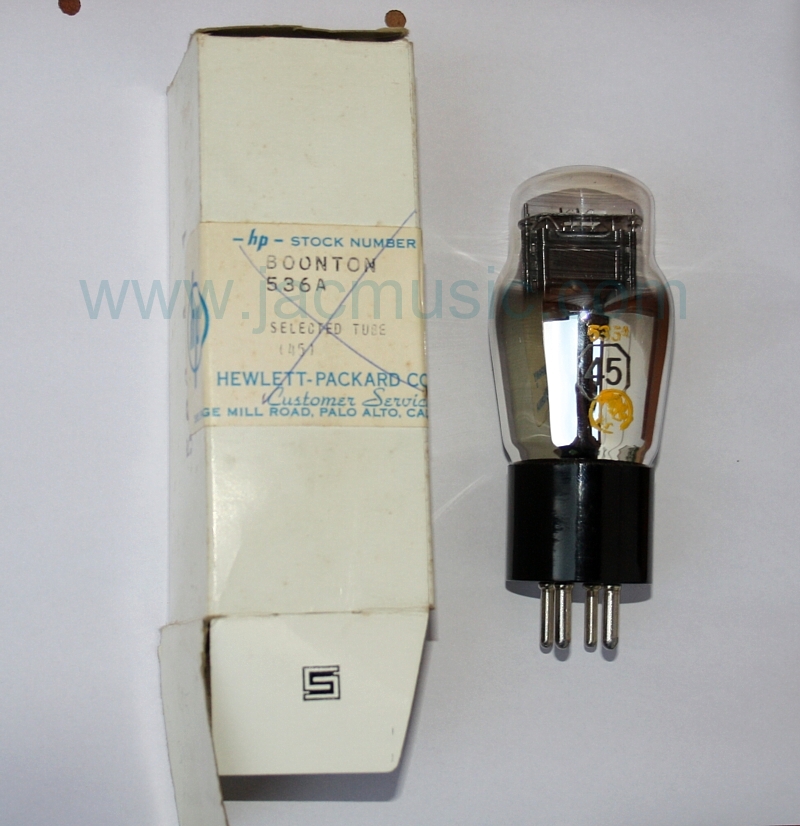536A Boonton Canada = SPECIALLY SELECTED TUBE (45)
. 
BOONTON 536A. Shiny new out of the box, unused after 50 years.
Made for the Hewlett Packard Customer Service Center, Page Mill road 395, Palo Alto, California.
Year of production unknown Link to Page Mill Road 395 website
I have an old Hewlett Packard Oscilloscope 430C, which some people call the last real good scope they made. And that was in the 1960's. I verified the amplifier tubes in there, they were the specially selected Telefunken <> tubes E88CC, made in Germany. They test weak in the "?" range meaning they may work well in some equipment, and not in the other. Well they work fine in this scope. They had a green dot on the top. I don't know what the dot means of course, but I found transconductance, gain, low leakage, perfect system match between two sections, it was all fully identical between the tubes. Better than with regular NOS Telefunken<> E88CC. Though these are very good, the green dot HP selected ones seem even better selected. The strange thing was, they were all quite worn, but worn all identical. So as they are, you can blindly replace one by the other. I think that was a good job of the design engineers, to make them wear out identical. (Even so, designing very reliable equipment with critical parts that are wearing out, that is an ancient art). For replacement you have to replace them all together of course, or you do end up with different tubes. It was impossible to find such tubes from a 100pcs box of 1980's Philips tubes. After testing 100 tubes, I gave it up. So they selected those tubes for HP really well, and today you can't repeat that anymore when the base quality of the lot is not very good to begin with. So replacing the worn out tubes by better ones, for me at the moment it is impossible. Yet, interesting when I put some random unselected tubes in there, the scope works perfectly just as well as it does on the worn tubes. An important observation is: The tubes seem overqualified for the products they are used in.
Why I write this? It seems to me, HP must have used simply the highest requirements for selected tubes, tolerating hardly any deviation from the datasheet. Today, it is the unrealistic dream of many audio amplifier designers, but here we talk about precision measurement tools, build in the 1950's, and tubes were for sale in massive quantities. I suppose HP just defined so, and they got away with it, as they were an important buyer. So it may not have even driven up the price very much.
So they ended up with one tube for many applications. I worked in R&D myself, and I remember we preferred to use components from released list, just to prevent the bother with releasing parts yourself. So when I found a higher temperature capacitor that list, where I needed only regular types, I often took the higher temperature one. Purchasing appreciated that, as they could buy one type in higher quantities. So taking an over-qualified part, it was often not a problem, and made things easier for everybody.
Now, knowing HP myself as my employer, I can easily imagine, with tubes in the 1950's that was not any different. They sort of wanted the best always. So once somebody puts a "Boonton 536A - specially selected 45" on the parts list, other designers easily take it. Then, at Boonton they get used to it, and already keep apart the very best 45 to send them for a higher price to HP.
You may find the above interesting, to see from a practical example what "specially selected for HP" means. I had similar experience when testing 5pcs Boonton 102A, which are know as specially selected 45 tubes as well. They were all fully identical, but ABOVE datasheet specifications.

Sorry for the price, but you will never find such quality again in the whole internet.
Price: 300 Euro for one tube. (19% VAT must be added for local sales).
(I have no pair)
==> Note for the buyer: Please print the test reports (pdf files from above) as this page may be moved to another location after sales.

